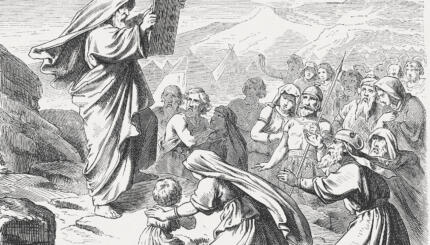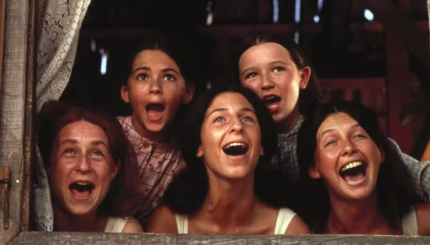The central ritual for welcoming boys into the Jewish people’s covenant with God, brit milah (ritual circumcision), is nearly as old as Jewishness itself. However, related ceremonies for girls are only a product of the last 30 years, and are not universally practiced. Though relatively new, these ceremonies are influenced by longstanding, diverse folks customs, as well as the ancient tradition of . The laws of the ancient Temples in Jerusalem called for sacrifices of thanksgiving after the birth of a child of either sex, and the Talmud records the custom in ancient Israel of planting trees when a child was born.
Ceremonies for Boys
 Brit milah is first mentioned–indeed, commanded–in the
, as a sign of the covenant and, perhaps, as a covenant unto itself. We read: “Every male among you shall be circumcised…it shall be a sign of the covenant between Me and you” (Genesis 17:11). Other “signs” are associated in the Torah with divine-human covenant, including
and the rainbow covenant with Noah after the flood.
Brit milah is first mentioned–indeed, commanded–in the
, as a sign of the covenant and, perhaps, as a covenant unto itself. We read: “Every male among you shall be circumcised…it shall be a sign of the covenant between Me and you” (Genesis 17:11). Other “signs” are associated in the Torah with divine-human covenant, including
and the rainbow covenant with Noah after the flood.
The Tanakh (the Hebrew Bible) refers to ears, lips, and the heart as having an orlah (the Hebrew word for “foreskin”), which can interfere with one’s ability to properly use them and to connect with God. Some ancient rabbinic and modern commentators speculate on the possible symbolism of generativity associated specifically with the foreskin of the penis; one rabbinic interpretation, or midrash, even playfully asks how Abraham knew it was that foreskin (and not another) which was to be “circumcised” (and answers by virtue of the connection between the covenantal promise of future generations and the male organ which would contribute to that promise).
In rabbinic thought, brit milah is described as being a sign, to God as well as oneself, of membership in the Jewish people’s covenant with God. The sages of the Talmudic period told many stories about the merits of circumcision to stress its importance–including its affecting (men’s) spiritual fate in World to Come. (Women are variously described as already being full members of the covenant; being included in men’s covenantal sign; or having their own sign in the monthly cycle of menstruation.) One explanation of circumcision’s importance reflects the notion that God has created a world beautiful but incomplete, leaving human beings to bring it to greater perfection.

Help us keep Jewish knowledge accessible to millions of people around the world.
Your donation to My Jewish Learning fuels endless journeys of Jewish discovery. With your help, My Jewish Learning can continue to provide nonstop opportunities for learning, connection and growth.
Circumcision was a widespread practice in the ancient world, and its practice within the Israelite nation gave it specific covenental meaning. Contemporary scholars of an anthropological bent point out a number of resonances to the practice–for example, circumcision as a social process linking different generations of men in a blood brotherhood, from which women were inherently excluded.
Through Jewish history, the practice of brit milah has often been hotly contested in the cultures in which Jews lived. In ancient Hellenistic culture, it was forbidden during the persecutions of Antiochus Epiphanes, the Syrian Hellenistic ruler who provoked the war of the Maccabees. Early Christians rejected circumcision as unnecessary. The animosity by non-Jews toward circumcisions continued into the Middle Ages under Christianity, but Jews did not face the same hostility to circumcision among Muslims, who also practiced it. In the modern period, even a few Jewish leaders (some 19th-century Reform thinkers) questioned the practice as tribal and antiquated. But circumcision remains one of Judaism’s most enduring practices.
 Ceremonies for Girls
Ceremonies for Girls
While ceremonies of covenant, welcome, and naming for girls have only taken place since the 1970s, Jews have acknowledged the birth of daughters in a number of ways in different times and cultures, particularly in various communities (whose members were descended from Jews of Spain, Portugal, and the Middle East). Among Ashkenazic Jews (those of German and Eastern European origin), it is a longstanding practice for baby girls to be formally given their names during the Torah service in the synagogue on a Shabbat morning.
The first known full-blown ceremony of welcoming, naming, and covenant for a girl was published in 1973. Similar ceremonies emerged in the Reform movement and elsewhere in the context of contemporary Jewish feminism. The creators of these ceremonies–which varied widely, especially initially–struggled to create appropriate liturgies and rituals that would be both new and authentic to Judaism. The 1970s and ’80s saw more ceremonies for girls, still among a relatively small number of Jews. Beginning in the mid-’80s and especially in the 1990’s, greater interest developed among laypeople and clergy alike. The 2001 publication of an entire book on ceremonies for girls is indicative of their increasing prevalence.
Ceremonies for girls are known by a wide variety of names: simchat bat (“celebrating a daughter”), brit bat (“a daughter’s covenant”), or simply “baby naming” are most common.


